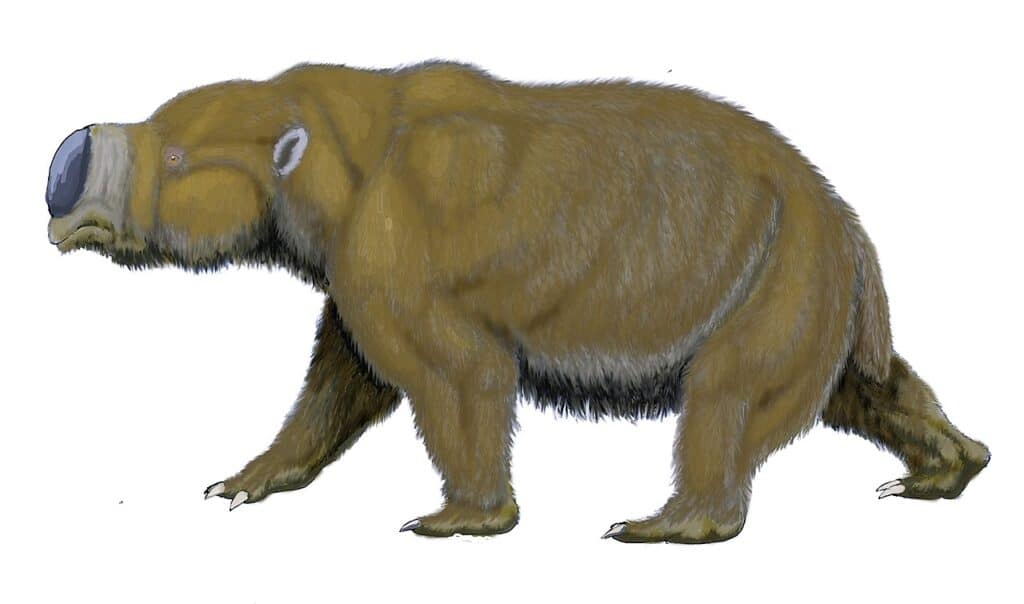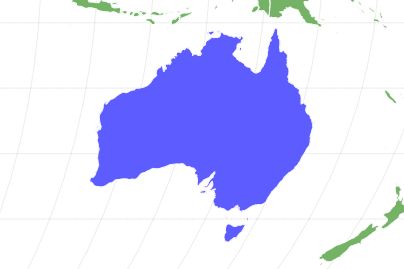Diprotodon
Diprotodon optatum
Diprotodon was the largest marsupial that ever lived.
Advertisement
Diprotodon Scientific Classification
- Kingdom
- Animalia
- Phylum
- Annelida
- Class
- Mammalia
- Order
- Diprotodontia
- Family
- Diprotodontidae
- Genus
- Diprotodon
- Scientific Name
- Diprotodon optatum
Read our Complete Guide to Classification of Animals.
Diprotodon Conservation Status
Diprotodon Facts
- Group Behavior
- Herd
- Fun Fact
- Diprotodon was the largest marsupial that ever lived.
- Biggest Threat
- Human activities, climate change
- Most Distinctive Feature
- Prominent front teeth
- Distinctive Feature
- Large belly
- Habitat
- Semi-arid plains, savannahs, and open woodlands
- Predators
- Thylacoleo carnifex, Giant crocodiles and humans
- Diet
- Herbivore
- Lifestyle
- Herd
- Type
- Prehistoric marsupial
- Common Name
- Giant wombat
- Special Features
- Molars and premolars formed a ridge for chewing
- Origin
- Australia
- Number Of Species
- 1
- Location
- Australia
View all of the Diprotodon images!
Diprotodon was one of the first fossil mammals from Australia. It is also one of the most well-known megafaunas in the world. Also known as the giant wombat, the Diprotodon is a much bigger version of the modern wombat and a close relative of the koalas. It lived for about 2.6 million years and went extinct roughly 50,000 years ago.
Description and Size

The name
Diprotodontranslates to “two forward teeth.”
Richard Owen named the Diprotodon in 1838. The name was formed from three Latin words “Di,” which means twice, “proto,” which means first; and “odon.” The name translates as “two forward teeth.” This marsupial genus was widespread across Australia during the Pleistocene epoch, especially before the arrival of humans. It co-existed with them for thousands of years before eventually becoming extinct.
Like many massive herbivores of its time, Diprotodon had a heavy quadruple build and a large belly. It had a long and narrow skull with a small brain case. The top of its head was depressed, a feature seen in many other marsupials. The skull also had an unusually large nasal aperture. Scientists think they either had a large nose or a short trunk.
The Diprotodon looked similar to modern wombats and koalas but was significantly larger. It had powerful limbs, with the upper limb slightly longer than the lower one. They exhibited sexual dimorphism, with the males somewhat bigger than the females.
On average, the giant wombats stood at about six feet tall at the shoulders and were about 12 feet long. Although their mass varied, they weighed up to three tons on average. Diprotodon was the largest marsupial that ever lived. It is still regarded as the largest plant-eating mammal of the Cenozoic Period. The marsupial had powerful 12-inch long incisors. Aside from this, many of their other cranial and dental features are similar to those of their modern cousins. The molars and premolars of the giant wombat formed a ridge that runs transversely from its cheek to its tongue. It served as a grating surface for chewing and crushing food.
Diet — What Did the Diprotodon Eat?
Diprotodon was a herbivorous animal. In fact, it is regarded as a megaherbivore, consuming as much as 220–330 pounds of vegetation daily. The large incisors of this marsupial helped pull vegetation from the ground. It consumed mostly shrubs, leaves, and grasses. The jaws of this carnivore were powerful. This would have allowed them to consume a wide range of plants, including tough, fibrous grasses.
Habitat — When and Where It Lived
Diprotodon lived in semi-arid plains, savannas, and open woodlands, during the Pleistocene Epoch. Generally, it avoided hilly and forested territories. It was prominent in certain coastal regions like the Kangaroo Island in South Australia and Naracoorte Caves. During the Pleistocene era, these areas were further from the coast as the sea levels were lower.
While it is not known from New Guinea in Southwestern Australia or the Northern Territory, it was present on King Island. Areas like Tambar and Cuddie Springs, Bacchus Marsh in Victoria, and Lake Callabonna, are prominently known today as the most famous habitats of the Diprotodon. Bones of the giant wombat have also been found in fossil deposits representing forest, plain, and woodland habitats.
Threats and Predators
The displayed fossil collection of Diprotodon at the Australian Museum features square holes made by a spear into the bone. Australian scientists believe this was the first evidence suggesting a predatory relationship between humans and the Diprotodon.
There is also evidence that Diprotodon was preyed upon by the marsupial carnivore known scientifically as Thylacoleo carnifex. A Diprotodon forelimb bone was discovered at Glen Innes, with dagger-like teeth marks that fit the lion‘s description. Evidence of the teeth was found at the location.
Juveniles were the ones targeted by marsupial lions. Gigantic monitor lizards like Megalania and Quintana, a plus-sized Australian crocodile, may have also targeted Diprotodon juveniles. Adult giant wombats would have been too big for these predators to handle.
Discoveries and Fossils — Where the Diprotodon Was Found
In a cave near Wellington, around New South Wales, the first Diprotodon remains were discovered by Bushman George Ranken in the company of Major Thomas Mitchell. The remains were sent to England for scientific study. Richard Owen studied the fossils and published his findings. Earlier studies mistook the bones for elephants or mastodons.
The oldest fossils are from late Pliocene deposits at Lake Kanunka in South Australia. Experts have also found complete skulls, skeletons, and hair and foot impressions of the animal around mainland Australia. The most detailed specimen of Diprotodon was excavated by paleontologists at Tambar Springs and displayed at the Coonabarabran visitor center in central New South Wales.
Diprotodon is a part of the Australian fossil museum collection. Scientist and researcher Ludwig Leichhardt would find more Diprotodon fossils from the bank creeks in Queensland’s Darling Downs in the 1840s. The largest specimens were around 9.8 feet long from nose to tail and 6,150 pounds.
One of the largest assemblages of Diprotodon fossil discoveries came from those that perished and were discovered in Lake Callabonna. More than 360 Diprotodon individuals were found in this location in the 1970s.
Extinction — When Did the Diprotodon Die Out?
Scientists don’t have accurate records on most animals that existed during the Australian Pleistocene. This has made it hard to pinpoint this marsupial’s exact period of extinction. There are varying opinions about when the giant wombat went extinct. However, most agree that they disappeared during the Quaternary extinction event about 60,000 years ago. This event wiped out all land animals heavier than 220 pounds from Australia.
A handful of modern researchers argue that the extinction of Diprotodon, alongside other megafaunas of the time, began shortly after the arrival of humans on the Australian continent 50,000 years ago. Others believe that the stress of climate change triggered the extinction to occur in stages before human arrival.
Generally, scientists think a combination of these three theories can explain the mass extinction of Diprotodon—climate change, human hunting activities, and drought. As climate change gradually destroyed Diprotodon’s habitat, the foliage it was accustomed to disappeared, and hungry humans hunted down the remaining herd members. Extreme drought situations are also regarded as one of the biggest causes of their extinction. Many Diprotodon fossils were discovered along shrinking lakes, obviously in search of water. During these desperate migrations, many crashed through crystalline lake surfaces and drowned.
Similar Animals to the Diprotodon
Similar animals to Diprotodon include:
- Wombat — The wombat is a short-legged quadrupedal marsupial native to Australia. The Diptorodon was a much larger version of this animal.
- Kangaroo — Kangaroos are marsupials native to Australia. They’re characterized by a small head, powerful hind legs, and a muscular tail for balance. The dentition of the giant wombat was quite similar to that of the kangaroo.
- Phascolonus — This is a genus of giant prehistoric marsupials in the wombat family. They lived alongside the Diprotodon on the Australian continent.
Related Animals…
View all 110 animals that start with DDiprotodon FAQs (Frequently Asked Questions)
How big was the Diprotodon?
The Diprotodon was a massive marsupial that stood at about 6ft at the shoulders. It was up to 12ft long, and the largest ones probably weighed up to 3 tons.
When was the Diprotodon alive?
Diprotodons lived between 2.6 million to 46,000 years ago. It is widely believed that a convergence of factors such as drought, human hunting, and climate change all orchestrated their disappearance.
Did the Diprotodon migrate?
Diprotodons migrated seasonally. They moved about 200 kilometers yearly and made the same round trips every year, following seasonal shifts in generation and rainfall. Thus, they’re the first time a marsupial on record migrates regularly.
Thank you for reading! Have some feedback for us? Contact the AZ Animals editorial team.
Sources
- Wikipedia / Accessed November 3, 2022
- Britannica / Accessed November 3, 2022
- Australian Museum / Accessed November 3, 2022
- Vedantu / Accessed November 3, 2022


















